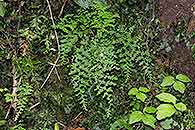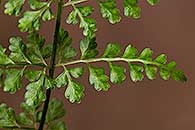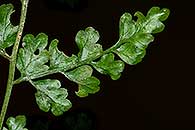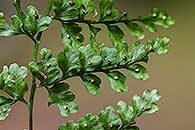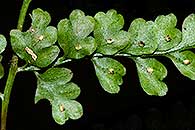Asplenium abyssinicum Fée
Synonyms |
Asplenium tenuifolium sensu Peter |
|---|---|
Common name |
|
Description |
Rhizome erect, dark brown; rhizome scales mid- to dark brown, up to 5.5 x 0.8 mm, linear in outline, apex gradually tapering to a slender point, margin entire. Fronds tufted, erect, not proliferous, herbaceous. Stipe dark brown, purplish or black, 3–30 cm long, base with scales similar to those of the rhizome, otherwise glabrous. Lamina membranous, delicate, bright green, ovate to lanceolate in outline, 10–40(–70) x 5–20 cm, 3-pinnate, the lowermost pinnae reduced, decrescent towards the apex. Pinnae mid-green, narrowly triangular in outline, up to 11 x 3.5 cm, unequally wedge-shaped at base, apex gradually tapering to a slender point. Pinnules ovate or rhombic-ovate in outline, lobed to pinnate, ultimate segments obovate in outline, apices rounded to obtuse, glabrous or with sparse scales to 0.1 mm long. Rhachis brown with thin green wings, hairless or nearly so. Sori 1–2 per segment, on the veins and facing towards the costule, ovoid, 0.5–2 mm long; indusium half-circular, membranous, entire, 0.7–1 mm wide. |
Notes | |
Derivation | abyssinicum: type specimen from Ethiopa (Abyssinia). |
Habitat | Moist forest, bamboo zone, woodland, occasionaly in moorland, but always in damp sites, along streams. |
Distribution worldwide | See African distribution. |
Distribution in Africa |
Burundi, Cameroon, Equatorial Guinea (incl. Bioko), Ethiopia, Kenya, Rwanda, Sudan and South Sudan, Tanzania , Uganda. |
Growth form |
Epiphytic, lithophytic, terrestrial. |
Literature |
|
